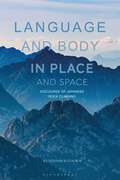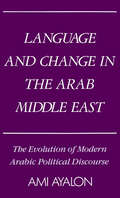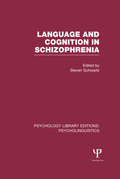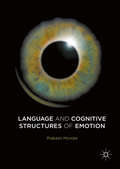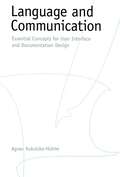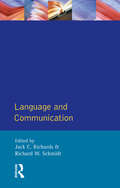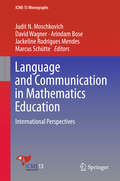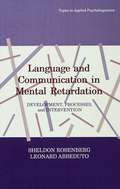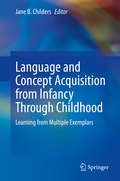- Table View
- List View
Language and Body in Place and Space: Discourse of Japanese Rock Climbing
by Kuniyoshi KataokaDrawing on the author's experience as a sociolinguist and a mountain climber, this book shows how the expertise and affect-laden experience of Japanese rock climbers can be illuminated through linguistic methods and theories. Through a detailed investigation of multimodal interaction among climbers, the book explores a number of significant sociolinguistic and linguistic anthropological themes, including spatial frames of reference, intersubjectivity, chronotopic configurations, and poetic formations of talk. In doing so, it presents climbing as a condensed locus of human interactions in which the integrated analysis of semiotic processes brings to light a new set of relationships between humans and their surroundings. Grounded in an extended and focused participation in rock climbing activities and interviews with other climbers, Kuniyoshi Kataoka examines the assemblage of semiotic resources including the language, the body, and the space mediated by their climbing equipment and the surrounding environment. The result is a showcase of interdisciplinary multimodal approaches to climbing discourse analysis in and around the gravity-sensitive zone, ranging from expert climbers' instruction to novices, gossip and narratives on near-death experiences, to a multi-participant discussion of a critical accident. As well as demonstrating how language reflects extraordinary experiences on the vertical plane, the findings also offer a chance to learn more about climbing, which is attracting a growing number of participants and competitors worldwide.
Language and Canadian Media: Representations, Ideologies, Policies
by Rachelle VesseyLanguage Ideologies and Canadian Media explores how French and English Canadian media discuss languages and language issues, which language ideologies predominate in English and French, and whether language ideologies in traditional news media are transferred to new and social media. Using corpus linguistics and discourse analysis and a variety of different datasets ranging from print newspapers to online news, commentary and Twitter, the author argues that language ideologies in Canadian media have a bearing not only on the extent to which Canadian language policies are adopted, but also on the very way that Canadians understand themselves and their place in the nation.
Language and Change in the Arab Middle East: The Evolution of Modern Arabic Political Discourse (Studies in Middle Eastern History)
by Ami AyalonMiddle Eastern society experienced sudden and profound change in the 19th century under the impact of European expansion and influence. But as Western ideas about politics, technology, and culture began to infiltrate Arab society, the old language proved to be an inadequate vehicle for transmitting these alien concepts from abroad. In this study of the rise of modern Arabic, Ayalon examines 19th-century linguistic change in the Eastern Arab world as a mirror of changing Arab perceptions and responses to the West as well as a guide to the emergence of modern Arabic concepts, institutions, and practices. Focusing on the realm of political discourse, Ayalon looks at a wide array of evidence--local chronicles, travel accounts, translations of European writings, Arab political treatises, newspapers and periodicals, and dictionaries--to show how shifts in the color, tone, and meaning of the Arab vocabulary reflected a new socio-political and cultural reality.
Language and Characterisation: People in Plays and Other Texts (Textual Explorations)
by Jonathan CulpeperTextual Explorations General Editors-Mick Short, Lancaster UniversityElena Semino, Lancaster UniversityThe focus of this series is on the stylistic analysis of literary and non-literary texts, and the theoretical issues which such work raises. Textual Explorations will include books that cover studies of literary authors, genres and other groupings, stylistic studies of non-literary texts, translation study, the teaching of language and literature, the empirical study of literature, and corpus approaches to stylistics and literature study. Books in the series will centre on texts written in English. Readership of the series is mainly undergraduate and postgraduate students, although advanced sixth formers will also find the books accessible. The series will be of particular interest to those who study English language, English literature, text linguistics, discourse analysis and communication studies. Language & Characterisation- People in Plays & Other Texts explores how the words of a text create a particular impression of a character in the reader's mind. Drawing together theories from linguistics, social cognition and literary stylistics, it is the first book-length study to focus on: the role of language and characterisation characterisation in the dialogue of play texts Containing numerous examples from Shakespeare's plays, the book also considers a wide range of other genres, including, prose fiction, verse, films, advertisements, jokes and newspapers. Language and Characterisation is as practical as it is theoretical and equips readers with analytical frameworks to reveal and explain both the cognitive and the linguistic sides of characterisation. Clear and detailed introductions are given to the theories, and useful suggestions for further analysis are also made at the end of each part of the book. The book will be essential reading for students and researchers of language, literature and communication.
Language and Characterisation: People in Plays and Other Texts (Textual Explorations)
by Jonathan CulpeperTextual Explorations General Editors-Mick Short, Lancaster UniversityElena Semino, Lancaster UniversityThe focus of this series is on the stylistic analysis of literary and non-literary texts, and the theoretical issues which such work raises. Textual Explorations will include books that cover studies of literary authors, genres and other groupings, stylistic studies of non-literary texts, translation study, the teaching of language and literature, the empirical study of literature, and corpus approaches to stylistics and literature study. Books in the series will centre on texts written in English. Readership of the series is mainly undergraduate and postgraduate students, although advanced sixth formers will also find the books accessible. The series will be of particular interest to those who study English language, English literature, text linguistics, discourse analysis and communication studies. Language & Characterisation- People in Plays & Other Texts explores how the words of a text create a particular impression of a character in the reader's mind. Drawing together theories from linguistics, social cognition and literary stylistics, it is the first book-length study to focus on: the role of language and characterisation characterisation in the dialogue of play texts Containing numerous examples from Shakespeare's plays, the book also considers a wide range of other genres, including, prose fiction, verse, films, advertisements, jokes and newspapers. Language and Characterisation is as practical as it is theoretical and equips readers with analytical frameworks to reveal and explain both the cognitive and the linguistic sides of characterisation. Clear and detailed introductions are given to the theories, and useful suggestions for further analysis are also made at the end of each part of the book. The book will be essential reading for students and researchers of language, literature and communication.
Language and Classification: Meaning-Making in the Classification and Categorization of Ceramics (Routledge Studies in Sociolinguistics)
by Allison BurketteThis volume adopts a practice-based approach to examine the different ways in which classification is communicated and negotiated in different environments within archaeology. The book looks specifically at the archaeological classification of ceramics as a lens through which to examine the discursive and social practices inherent in the classification and categorization process, with perspectives from such areas as corpus linguistics, discourse analysis, linguistic anthropology, and archaeology forming the foundation of the book’s theoretical framework. The volume then looks at the process of classification in practice in a variety of settings, including a university course on ceramics classification, an archaeological field school, an intensive petrography course, and archaeometry laboratory at a nuclear research reactor, and highlights participant observation and audiovisual data taken from fieldwork practice completed in these environments. This volume offers a valuable contribution to the growing literature on language and material culture, making this a key resource for students and scholars in sociolinguistic, anthropological linguistics, archaeology, discourse analysis, and anthropology.
Language and Classification: Meaning-Making in the Classification and Categorization of Ceramics (Routledge Studies in Sociolinguistics)
by Allison BurketteThis volume adopts a practice-based approach to examine the different ways in which classification is communicated and negotiated in different environments within archaeology. The book looks specifically at the archaeological classification of ceramics as a lens through which to examine the discursive and social practices inherent in the classification and categorization process, with perspectives from such areas as corpus linguistics, discourse analysis, linguistic anthropology, and archaeology forming the foundation of the book’s theoretical framework. The volume then looks at the process of classification in practice in a variety of settings, including a university course on ceramics classification, an archaeological field school, an intensive petrography course, and archaeometry laboratory at a nuclear research reactor, and highlights participant observation and audiovisual data taken from fieldwork practice completed in these environments. This volume offers a valuable contribution to the growing literature on language and material culture, making this a key resource for students and scholars in sociolinguistic, anthropological linguistics, archaeology, discourse analysis, and anthropology.
Language and Cognition in Schizophrenia (Psychology Library Editions: Psycholinguistics)
by Steven SchwartzOriginally published in 1978, the contributors to this volume, including the leading figures in experimental psychopathology, were largely concerned with deducing the behaviour of schizophrenics from general psychological theories of language, learning and cognition. Their emphasis on deduction reflected a modern reliance on laboratory experimentation, and, taken as a whole, the chapters cover the breadth and variety of current approaches of the time to the study of schizophrenic language and cognition. The first part of the volume is concerned with recent developments in the study of schizophrenic language. The second part deals with various aspects of schizophrenic cognition. The final chapter, by the editor, attempts to review and integrate what was currently known about schizophrenic cognition and language. This chapter contrasts the various experimental methodologies used to validate theories by pointing out areas of agreement and disagreement as well as possible directions for future theory and research. Here is a book that at the time presented the most up-to-date overview available on language and thought in schizophrenia. Today it can be read and enjoyed in its historical context.
Language and Cognition in Schizophrenia (Psychology Library Editions: Psycholinguistics)
by Steven SchwartzOriginally published in 1978, the contributors to this volume, including the leading figures in experimental psychopathology, were largely concerned with deducing the behaviour of schizophrenics from general psychological theories of language, learning and cognition. Their emphasis on deduction reflected a modern reliance on laboratory experimentation, and, taken as a whole, the chapters cover the breadth and variety of current approaches of the time to the study of schizophrenic language and cognition. The first part of the volume is concerned with recent developments in the study of schizophrenic language. The second part deals with various aspects of schizophrenic cognition. The final chapter, by the editor, attempts to review and integrate what was currently known about schizophrenic cognition and language. This chapter contrasts the various experimental methodologies used to validate theories by pointing out areas of agreement and disagreement as well as possible directions for future theory and research. Here is a book that at the time presented the most up-to-date overview available on language and thought in schizophrenia. Today it can be read and enjoyed in its historical context.
Language and Cognitive Structures of Emotion
by Prakash MondalThis book examines linguistic expressions of emotion in intensional contexts and offers a formally elegant account of the relationship between language and emotion. The author presents a compelling case for the view that there exist, contrary to popular belief, logical universals at the intersection of language and emotive content. This book shows that emotive structures in the mind that are widely assumed to be not only subjectively or socio-culturally variable but also irrelevant to a general theory of cognition offer an unusually suitable ground for a formal theory of emotive representations, allowing for surprising logical and cognitive consequences for a theory of cognition. Challenging mainstream assumptions in cognitive science and in linguistics, this book will appeal to linguists, philosophers of the mind, linguistic anthropologists, psychologists and cognitive scientists of all persuasions.
Language and Communication: Essential Concepts for User Interface and Documentation Design
by Agnes Kukulska-HulmeComputer interfaces and documentation are notoriously difficult for any user, regardless of his or her level of experience. Advances in technology are not making applications more friendly. Introducing concepts from linguistics and language teaching, Language and Communication proposes a new approach to computer interface design. The book explains for the first time why the much hyped user-friendly interface is treated with such derision by the user community. The author argues that software and hardware designers should consider such fundamental language concepts as meaning, context, function, variety, and equivalence. She goes on to show how imagining an interface as a new language can be an invaluable design exercise, calling into question deeply held beliefs and assumptions about what users will or will not understand. Written for a wide range of computer scientists and professionals, and presuming no prior knowledge of language-related terminology, this volume is a key step in the on-going information revolution.
Language and Communication
by Jack C. Richards R. W. SchmidtPresents eight specially written chapters which provide a coherent survey of major issues in the study of language and communication, and which show how these are related to questions of practical concern in the learning and teaching of second and foreign languages. The issues discussed have been selected primarily for their relevance to applied linguistics, and there is a unifying interest in how language reflects the communicative functions it performs as well as in the process involved in using language for communication. Each chapter presents a self-contained survey of a central issue, is prefaced by an introduction linking the different perspectives, and is followed by discussion questions to aid effective use of the text in applied linguistics courses.
Language and Communication
by Jack C. Richards R. W. SchmidtPresents eight specially written chapters which provide a coherent survey of major issues in the study of language and communication, and which show how these are related to questions of practical concern in the learning and teaching of second and foreign languages. The issues discussed have been selected primarily for their relevance to applied linguistics, and there is a unifying interest in how language reflects the communicative functions it performs as well as in the process involved in using language for communication. Each chapter presents a self-contained survey of a central issue, is prefaced by an introduction linking the different perspectives, and is followed by discussion questions to aid effective use of the text in applied linguistics courses.
Language and Communication in Mathematics Education: International Perspectives (ICME-13 Monographs)
by Judit N. Moschkovich David Wagner Arindam Bose Jackeline Rodrigues Mendes Marcus SchütteThis book considers some of the outstanding questions regarding language and communication in the teaching and learning of mathematics – an established theme in mathematics education research, which is growing in prominence. Recent research has demonstrated the wide range of theoretical and methodological resources that can contribute to this area of study, including those drawing on cross-disciplinary perspectives influenced by, among others, sociology, psychology, linguistics, and semiotics. Examining language in its broadest sense to include all modes of communication, including visual and gestural as well as spoken and written modes, it features work presented and discussed in the Language and Communication topic study group (TSG 31) at the 13th International Congress on Mathematical Education (ICME-13). A joint session with participants of the Mathematics Education in a Multilingual and Multicultural Environment topic study group (TSG 32) enhanced discussions, which are incorporated in elaborations included in this book. Discussing cross-cutting topics it appeals to readers from a wide range of disciplines, such as mathematics education and research methods in education, multilingualism, applied linguistics and beyond.
Language and Communication in Mental Retardation: Development, Processes, and intervention (Topics in Applied Psycholinguistics Series)
by Sheldon Rosenberg Leonard AbbedutoResearch on language and communication development and intervention in persons with mental retardation has been conducted at a fast and furious pace during the last two decades. Past attempts to summarize this research have been rather restricted, focusing on a single, narrowly defined substantive domain such as lexical development, or of a single etiology such as Down Syndrome. This volume, in contrast, presents a critical, integrative review of research and theory on language development and processing across all domains and a variety of etiologies. In addition, many previous attempts to review portions of this research have failed to consider the research within the context of current theory and data from developmental psycholinguistics and linguistics. A major contribution of this book is the emphasis on relevant work outside of mental retardation for understanding and treating the language and communication problems of persons with mental retardation. Finally, this book is comprehensive and up-to-date across all the areas of language covered including appropriate introductory material in linguistics and psychology -- discussions of the innateness, cognition-first and motherese views of normal language acquisition. In addition, the authors' extensive bibliography is valuable in and of itself to any serious student or professional in the area.
Language and Communication in Mental Retardation: Development, Processes, and intervention (Topics in Applied Psycholinguistics Series #Volume 27)
by Sheldon Rosenberg Leonard AbbedutoResearch on language and communication development and intervention in persons with mental retardation has been conducted at a fast and furious pace during the last two decades. Past attempts to summarize this research have been rather restricted, focusing on a single, narrowly defined substantive domain such as lexical development, or of a single etiology such as Down Syndrome. This volume, in contrast, presents a critical, integrative review of research and theory on language development and processing across all domains and a variety of etiologies. In addition, many previous attempts to review portions of this research have failed to consider the research within the context of current theory and data from developmental psycholinguistics and linguistics. A major contribution of this book is the emphasis on relevant work outside of mental retardation for understanding and treating the language and communication problems of persons with mental retardation. Finally, this book is comprehensive and up-to-date across all the areas of language covered including appropriate introductory material in linguistics and psychology -- discussions of the innateness, cognition-first and motherese views of normal language acquisition. In addition, the authors' extensive bibliography is valuable in and of itself to any serious student or professional in the area.
Language and Community in Early England: Imagining Distance in Medieval Literature
by Emily ButlerThis book examines the development of English as a written vernacular and identifies that development as a process of community building that occurred in a multilingual context. Moving through the eighth century to the thirteenth century, and finally to the sixteenth-century antiquarians who collected medieval manuscripts, it suggests that this important period in the history of English can only be understood if we loosen our insistence on a sharp divide between Old and Middle English and place the textuality of this period in the framework of a multilingual matrix. The book examines a wide range of materials, including the works of Bede, the Alfredian circle, and Wulfstan, as well as the mid-eleventh-century Encomium Emmae Reginae, the Tremulous Hand of Worcester, the Ancrene Wisse, and Matthew Parker’s study of Old English manuscripts. Engaging foundational theories of textual community and intellectual community, this book provides a crucial link with linguistic distance. Perceptions of distance, whether between English and other languages or between different forms of English, are fundamental to the formation of textual community, since the awareness of shared language that can shape or reinforce a sense of communal identity only has meaning by contrast with other languages or varieties. The book argues that the precocious rise of English as a written vernacular has its basis in precisely these communal negotiations of linguistic distance, the effects of which were still playing out in the religious and political upheavals of the sixteenth century. Ultimately, the book argues that the tension of linguistic distance provides the necessary energy for the community-building activities of annotation and glossing, translation, compilation, and other uses of texts and manuscripts. This will be an important volume for literary scholars of the medieval period, and those working on the early modern period, both on literary topics and on historical studies of English nationalism. It will also appeal to those with interests in sociolinguistics, history of the English language, and medieval religious history.
Language and Community in Early England: Imagining Distance in Medieval Literature
by Emily ButlerThis book examines the development of English as a written vernacular and identifies that development as a process of community building that occurred in a multilingual context. Moving through the eighth century to the thirteenth century, and finally to the sixteenth-century antiquarians who collected medieval manuscripts, it suggests that this important period in the history of English can only be understood if we loosen our insistence on a sharp divide between Old and Middle English and place the textuality of this period in the framework of a multilingual matrix. The book examines a wide range of materials, including the works of Bede, the Alfredian circle, and Wulfstan, as well as the mid-eleventh-century Encomium Emmae Reginae, the Tremulous Hand of Worcester, the Ancrene Wisse, and Matthew Parker’s study of Old English manuscripts. Engaging foundational theories of textual community and intellectual community, this book provides a crucial link with linguistic distance. Perceptions of distance, whether between English and other languages or between different forms of English, are fundamental to the formation of textual community, since the awareness of shared language that can shape or reinforce a sense of communal identity only has meaning by contrast with other languages or varieties. The book argues that the precocious rise of English as a written vernacular has its basis in precisely these communal negotiations of linguistic distance, the effects of which were still playing out in the religious and political upheavals of the sixteenth century. Ultimately, the book argues that the tension of linguistic distance provides the necessary energy for the community-building activities of annotation and glossing, translation, compilation, and other uses of texts and manuscripts. This will be an important volume for literary scholars of the medieval period, and those working on the early modern period, both on literary topics and on historical studies of English nationalism. It will also appeal to those with interests in sociolinguistics, history of the English language, and medieval religious history.
Language and Computers
by Markus Dickinson Chris Brew Detmar MeurersLanguage and Computers introduces students to the fundamentals of how computers are used to represent, process, and organize textual and spoken information. Concepts are grounded in real-world examples familiar to students’ experiences of using language and computers in everyday life. A real-world introduction to the fundamentals of how computers process language, written specifically for the undergraduate audience, introducing key concepts from computational linguistics. Offers a comprehensive explanation of the problems computers face in handling natural language Covers a broad spectrum of language-related applications and issues, including major computer applications involving natural language and the social and ethical implications of these new developments The book focuses on real-world examples with which students can identify, using these to explore the technology and how it works Features “under-the-hood” sections that give greater detail on selected advanced topics, rendering the book appropriate for more advanced courses, or for independent study by the motivated reader.
Language and Computers
by Markus Dickinson Chris Brew Detmar MeurersLanguage and Computers introduces students to the fundamentals of how computers are used to represent, process, and organize textual and spoken information. Concepts are grounded in real-world examples familiar to students’ experiences of using language and computers in everyday life. A real-world introduction to the fundamentals of how computers process language, written specifically for the undergraduate audience, introducing key concepts from computational linguistics. Offers a comprehensive explanation of the problems computers face in handling natural language Covers a broad spectrum of language-related applications and issues, including major computer applications involving natural language and the social and ethical implications of these new developments The book focuses on real-world examples with which students can identify, using these to explore the technology and how it works Features “under-the-hood” sections that give greater detail on selected advanced topics, rendering the book appropriate for more advanced courses, or for independent study by the motivated reader.
Language and Concept Acquisition from Infancy Through Childhood: Learning from Multiple Exemplars
by Jane B. ChildersThis book examines the role of experience-based learning on children’s acquisition of language and concepts. It reviews, compares, and contrasts accounts of how the opportunity to recognize and generalize patterns influences learning. The book offers the first systematic integration of three highly influential research traditions in the domains of language and concept acquisition: Statistical Learning, Structural Alignment, and the Bayesian learning perspective. Chapters examine the parameters that constrain learning, address conditions that optimize learning, and offer explanations for cases in which implicit exemplar-based learning fails to occur. By exploring both the benefits and challenges children face as they learn from multiple examples, the book offers insight on how to better able to understand children’s early unsupervised learning about language and concepts. Topics featured in this book include:Competing models of statistical learning and how learning might be constrained by infants’ developing cognitive abilities.How experience with multiple exemplars helps infants understand space and other relations.The emergence of category-based inductive reasoning during infancy and early childhood.How children learn individual verbs and the verb system over time. How statistical learning leads to aggregation and abstraction in word learning.Mechanisms for evaluating others’ reliability as sources of knowledge when learning new words.The Search for Invariance (SI) hypothesis and its role in facilitating causal learning. Language and Concept Acquisition from Infancy Through Childhood is an essential resource for researchers, clinicians and related professionals, and graduate students in infancy and early child development, applied linguistics, language education, child, school, and developmental psychology and related mental health and education services.
Language and Conflict: Selected Issues
by Karol JanickiWhat role does language and communication play in conflict? Why do people engage in or get drawn into quarrels? How can our awareness of the social rules of language use prevent disputes? In this illuminating and accessible guide, Karol Janicki takes the reader on a tour through the field of conflict in language. Using real-life examples, the book examines how language usage influences conflict, and what people can do to avoid or resolve it. Language and Conflict- ends each chapter with a story that neatly summarizes the key discussion points in a clear, digestible format - provides useful 'hands-on' tips and further reading recommendations for those who want to explore the subject furtherThis book is ideal reading for undergraduates studying discourse analysis, language and communication, sociolinguistics, or applied linguistics, and for general readers new to the subject of language and conflict.
Language and Conflict in Northern Ireland and Canada: A Silent War (Palgrave Studies in Minority Languages and Communities)
by J. MullerIn a unique contribution to understanding the interaction of language policy and planning in modern conflict resolution, Janet Muller provides an insider account of the search for improved status for the Irish language in Northern Ireland from the 1980s.
Language and Context: A Functional Linguistic Theory Of Register
by Helen Leckie-TarryLanguage and Context breaks new ground in our understanding of the relationship between register, genre and context. Leckie-Tarry argues convincingly and engagingly for a functional theory of language which specifies register in terms of contextual and linguistic features, and which suggests a discursive relationship between the two. Moving beyond the limits of much of today's theory, this accessible volume develops a theoretical understanding of the relationship between text, context, langage function and linguistic form. Helen Leckie-Tarry, a specialist in the area of 'register and applied linguistics', died in 1991, aged 49. Although she had finished a large part of this work, her notes and draft chapters have been extensively edited by Professor David Birch. David Birch is currently Professor of Communication and media Studies at Central Queensland University, Australia, and previously taught at Murdoch University, Western Australia, and the National University of Singapore.
Language and Control in Children's Literature
by Murray Knowles Kirsten MalmkjaerThis study examines the work of children's writers from the 19th and 20th centuries in order to expose the persuasive power of language. Looking at the work of 19th century English writers of juvenile fiction, Knowles and Malmkjaer expose the colonial and class assumptions on which the books were predicated. In the modern teen novel and the work of Roald Dahl the authors find contemporary attempts to control children within socially established frameworks. Other authors discussed include, Oscar Wilde, E. Nesbit, Lewis Carroll and C.S. Lewis.
